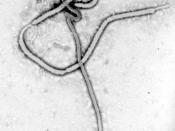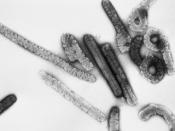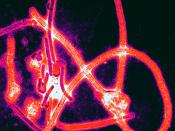The 1976 year brought to the world a new spine-chilling virus which terrified scientist, medical workers and everyone who heard about it. It first appearance was detected in German city Marburg, which gave the virus its name. Later that year, the scientist world was stunned by the appearance of another virus in southern Sudan. In two month analogous virus emerged in Zarie. All three viruses caused the hemorrhagix fever with the similar symptoms and belonged to group of filoviruses.
The researchers continue to research more about filoviruses and they found that Ebola virus , which are the second genus of filovirus family can infect dendritic cells which are antigen presenting cells blocking the body's ability to start the adaptive immune response. Dendritic cells secrete tumor necrosis factor (TNF-alpha), IL-1(beta), IL-6 which active T-cells to begin the antigen-specific immune response. However, since the Ebola virus reducing the secretion of these proinflammatory cytokines and chemokines, the immune mechanisms of the body cannot function properly anymore.
Lymphocytes do not get infected by virus directly but suffer from apoptosis, cellular death that occurs as a part programmed cell death and other events which cause membranes to become bubbled and the nuclei condensed. Since the virus primarily target is immune system, virus rapidly spreads through the body causing the death of the host in one or two weeks. In the same time virus invades the body cells and copies itself through the genetic material in a single strand RNA. The process continues until the every alive cells is infected with the virus.
The symptoms of the filoviruses worse that any nightmare, however scientists discovered that in some people Ebola virus doesn't cause any symptom. The early symptoms of the disease can be easily misdiagnosed as malaria, pneumonia, yellow fever or some other bacterial infections. It starts with a redness of the eye, fever and headache. Shortly, pain spreads through all the body.
The history and abilies of viruses is impossible to ignore, since the more and more viruses appear every year. Many of them are mutation of old harmless viruses. So the studying of the old virus may give a foundation for understanding the later emerged virus.
http://en.wikipedia.org/wiki/Filoviridae
http://www.cdc.gov/ncidod/dvrd/spb/mnpages/dispages/Fact_Sheets/Filovirus_Fact_Sheet.pdf





